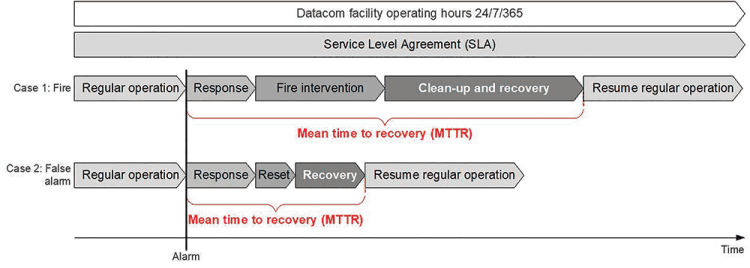
The global data centre market is expected to post a CAGR of more than 17% during the period 2019-2023, involving ICT infrastructure, power management systems, mechanical construction, general construction and security solutions – of which fire protection is an important part.
A key factor driving the growth of the global data centre market size is the rise in adoption of multi-cloud and network upgrades to support 5G. Multi-cloud has gained significant prominence in recent times due to its key role in preventing data loss or downtime, ensures security compliances and meets workload requirements. Thus, multiple public and private clouds are being leveraged by enterprises for different application workloads.

Resilience is paramount to operation reliability
Apart from the need for on-site security, 24/7/365 monitoring, routine scheduled inspection and maintenance as well as access to a reliable network and communications infrastructure, datacom facilities operation reliability is subject to the rigorousness of:
• Power resilience (e.g. transformers, generators, UPS).
• Mechanical resilience (e.g. HVAC/cooling, backup power).
• Fire resilience (e.g. early warning firedetection, passive fire-rated protection measures, fire suppression and logic controls).
A central element of fire resilience is early warning fire detection. Compared to a normal built environment where mechanical forced ventilation (such as an HVAC system) usually delivers no more than 60 air changes per hour (ACH), in modem data centres well over 100 ACH are common. When cold-aisle/hot-aisle containment design becomes popular, airflow and air turbulence within these essentially compartmented spaces increases dramatically. Hence early and reliable smoke detection in these high-risk areas becomes difficult due to fast moving and highly diluted smoke.
Fire incidents affect service level agreements
Most, if not all datacom facilities are designed to deliver managed services, collocation services or large corporate host-services of its own business ecosystem. A service level agreement (SLA) is a common form of commitment from service providers to end customers with defined, measurable criteria for specific level of high service availability. The reliability of datacom operation is the key to fulfil SLA commitments.
Naturally, any fire or non-fire incident, such as a false fire alarm can result in significant downtime of the facility operation and services. To the contrary, a reliable early warning fire detection system provides pre-signal alerts so potential fire incidents are dealt with well before any interruption to the service occurs.

Challenges to early warning fire detection
While statistical causes for overall outages of datacom facilities due to fire are low, the risk of a fire in the electronic equipment areas remains very high, in particular from the electrical power distribution related apparatus. Potentially delayed power-downs or changes of HVAC operation for effective automatic suppression activation when needed, may result in a fire spreading beyond its location of origin. Therefore, the consequences of a fire not being detected early, increase significantly.
Designing an early warning fire detection for specific fire risk mitigation is of fundamental importance to ensure business continuity. While there are practical difficulties in choosing suitable detection products, SecuriSmoke ASD Early Warning Fire Detection systems address all the key challenges in order to deliver early and reliable fire detection (see Table 1).
Early warning fire detection design
Fire protection professionals must work within the prescriptive constraints of the applicable building codes and standards while applying best engineering practices to address industry and building occupancy specific needs. In particular, the risks and requirements for uninterrupted mission critical business operation in datacom facilities must be adequately addressed. In this regard, a performance-based design (PBD) approach to the optimisation of fire detection, fire protection and human interaction to supplement prescriptive baseline design is key to meeting the requirements for building and life safety as well as risk management.
When combining prescriptive and PBD approaches to design a fit-for-purpose fire detection system for a datacom facility, it is important to select advanced SecuriSmoke ASD detection products. SecuriSmoke ASD products allow full flexible design with quantifiable and reliable detection performance. Advantages include a wide range of models, maximum number of holes with each sensitivity class, long aggregated pipe length, five levels of staged responses and signal interface to suppression and BMS components.
The Design Guide for early warning fire detection for the datacom industry, describing in detail the various design criteria, can be downloaded from www.securiton.com.

© Technews Publishing (Pty) Ltd. | All Rights Reserved.